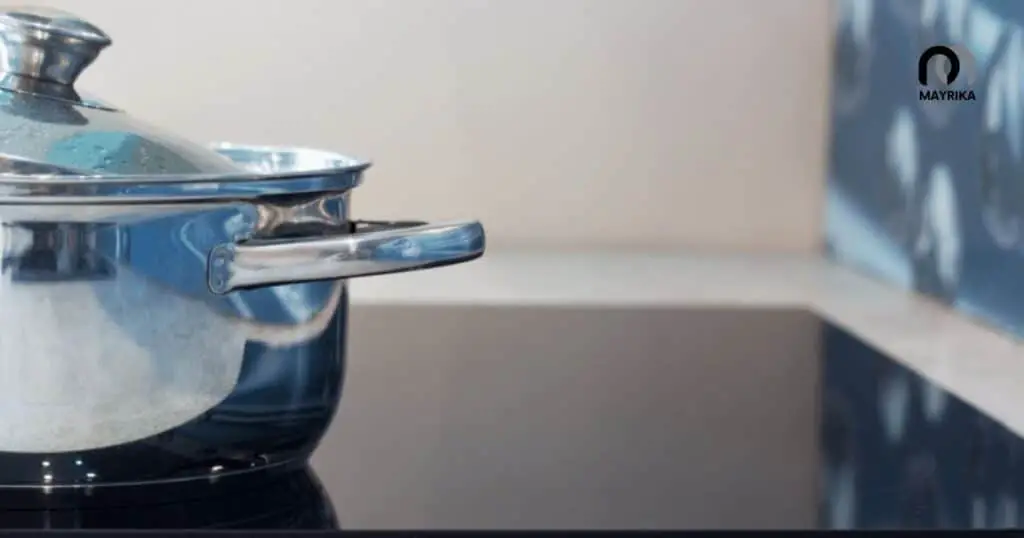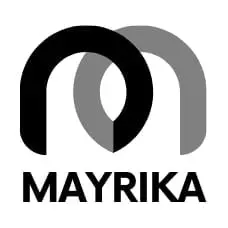Induction cooking is quickly becoming the most popular way to cook. It’s faster and more efficient than traditional cooking methods. It doesn’t heat your kitchen as much, and you can cook on one side while doing other things in the kitchen!
For those looking to purchase a new induction stove or oven, make sure that your pot or pan is made from ferromagnetic metals like stainless steel, cast iron, aluminum alloy, copper core, nickel-chrome alloys.
If you’re not sure whether or not your current pots are induction ready, then check out this article for helpful tips on how to tell if cookware is induction ready!
Differences between induction cooktops and conventional cooktops
The difference is temperature regulation. Induction cooking operates at a specific heat level for an extended period. In contrast, conventional cooking increases the heat with each utensil used.
If you don’t need to account for high heat settings when using your cookware or food, induction cooking is better because it does not require voltage spikes on start-up.
In a conventionally heated stovetop, the element is hot when the handle is turned, and there’s electricity in the circuit.
On an inductive heat stovetop, the cooking surface has electrically neutral zones energized by magnetic fields generated by coils in surrounding metal backsplashes.
The induction heating process only heats what you put on it and therefore cooks more evenly than ordinary heat, which warms from all sides.
It also heats faster because it doesn’t need to suck away warmth from surrounding surfaces to do its work or give up its heat to the environment.
Thermal transfers can occur within specially designed cooktops instead of cool air like old-fashioned gas units requiring ventilation holes for proper operation.
Related: The 12 Best Stainless Steel Cookware For Induction Cooking
What makes cookware induction ready?
The metal’s surface must have a magnetic oxide layer of at least 9.5 mm (0.378 inches) thick to conduct heat effectively.
That it must be even, without any protrusions or low spots; any gaps where the two surfaces meet (less than 0.2mm or 0.078 in) will block the flow of electricity and prevent an induction cooktop from properly functioning.
Although some inexpensive models don’t seem to require precise tolerances. It doesn’t work with copper or aluminum cookware since these metals are not magnetic.
The essential factor in deciding if your cookware is induction ready is to check that your cookware does not contain ferrous metals or particles.
This will cause problems as microwaves bounce off these materials rather than being transferred through them to create heating heat within the pan.
Another factor in deciding if your cookware is induction ready is to check that it has a consistent thickness throughout its cooking area (i.e., flat base).
Thus, allowing for the perfect transfer of energy from an electromagnetic field into thermal electricity when placed on an electromagnetic field induction-ready surface.
To cook on an induction cooktop with a non-induction compatible pot or pan, the cook must ensure the cookware is conductive or has a converter disk between the cookware and the cooktop.

Benefits of induction cooking
Induction cooking offers a range of benefits, saving you energy to lower your electric bills, and it’s fast. One point that should be noted is that induction cooking is not as powerful as traditional electrical appliances like the electric stove or oven.
So if you have a large pot or pan, use something else when heating food because it may take longer.
Induction cooking consists of magnetic coils embedded in the bottom plate with an electrically conducting liquid metal spread by thin wires over much of the bottom surface.
Specialized cookware must be used for induction cooking. Pots and pans have a ferromagnetic layer caused by atomic layers on their surface to interact with the magnetic field generated.
When using such a device, food is not stirred or flipped and exposes no surface area to air while in contact with the pan. This allows for rapid and complete moisture vaporization from all areas of the food at once.
In addition, higher boiling point liquids like milk are more convenient and taste better when cooked this way.
Cooking with induction is convenient for households with many people or children because it eliminates the risk of burning yourself on an element when you’re done.
Healthier cooking: The induction heating process only warms the pan, so there’s no need to worry about what your food has been touching. While it was in the oven, you have to be careful about using plastics around any heat source.

What are the differences between magnetized and non-magnetized stainless steel?
More specifically, low carbon steel is magnetically attracted to magnets due to iron carbide grains throughout the metal.
This iron carbide can also be found in paper clips or other metal fasteners like bolts and nuts. These items get their form using a liquid silicone mold or an electric current arc.
Non-magnetic stainless steel lacks this iron carbide, so thin nails won’t “stick” unless applied directly to the pin.
Stainless steels are steel alloys with at least 11% chromium content, and the majority of these steels contain nickel. Both elements inhibit corrosion, meaning stainless steel is more resistant to rust or oxidation than regular carbon steel.
The metal’s ability to prevent iron from reacting with oxygen in the presence of water or moist air. The strength and durability of this material make it an ideal construction material for high-quality kitchen knives.
However, some debate over whether magnetized stainless steel blades might lead to an increased risk of injury versus non-magnetic stainless steel blade knives.
Testing pots and pans for induction compatible

One way of testing whether a pot or pan is induction compatible with an induction cooker is to take the pot or pan and make a (small) circle-shaped blister on the surface with your burner.
If the black burn mark disappears in around 5 seconds, it’s not suitable for induction cooking. If you’re fortunate, you might be able to use your already tested pots and pans on an induction stove just by changing their bottoms.
However, their bases can be changed using salvaged materials like smooth steel sheet metal from feed sacks (suitable foil thickness may also work).
Sheets of copper and aluminum flashing also work on rare occasions but have less “push” than the metal sheet.
The inefficiency of the induction element is dependent on the resistance of the material. Consequently, any material with a higher resistivity will require more heat, and less will be transferred to the base.
A non-magnetic layer will significantly increase inductive coil efficiency. Test when hot and not near an absorbing surface, such as a pot or countertop.
Use caution with rubber handle grips – by touching them, you may, for example, create sparks that could ignite nearby combustible materials. Finishes can generally be viewed through light reflection.
Still, care should be taken with green and yellow striped pots/pans, especially – they are either copper or just copper-plated. And this creates issues with testing due to electrical conductivity.
How to organize your induction cookware
There are so many types of cookware on the market, and they all have different needs. If you are purchasing a new set for your kitchen, we would highly recommend buying an induction cooker instead of relying on your old electric cooktop or gas burner.
Induction cooking is efficient, safer, generally does not require babysitting (your food will stop cooking when it’s done), and cleans up much faster.
Suppose you’re asking how to organize induction-ready cookware in particular. Then this just got a heck of a lot easier, rather than arranging by stockpot/fry pan size as most organized kitchens do today.
The key to organizing your induction-ready cookware is determining what items go into the various pots and pans.
For example, since it has a heavy bottom outside with lightweight susceptors, one promising idea for a pot is to put all of your soups and sauces in the bottom part of this pot.
For skillets or frying pans, grill veggies or fry an egg–anything that you want a more crusty surface. Instead of being cooked throughout would be better in these pans because of their weight distribution patterns.
Lastly, sautéing vegetables can be done on either side depending on where you want them to browner (the inside pan will make them browner).
What to consider when buying induction cookware
When you are looking to buy induction cookware, there are a few things you need to consider. The most important factor is the type of material the cookware is made from.
For induction cooking, you need cookware that is made from magnetic materials. This means that stainless steel and cast iron are your best options.
Another thing to consider is the size and shape of the cookware. Not all pots and pans will work on an induction stovetop. You need to make sure that the dimensions of the cookware are compatible with your stovetop.
Finally, you’ll want to think about price and brand. Induction cookware can be expensive, but there are some affordable options available if you know where to look.
And, as with any other type of cookware, there are a number of high-quality brands to choose from.
Final Words
After reading this blog post, you should know how to tell if cookware is induction ready and the differences between conventional and induction stovetops.
You will also learn what makes cookware induction-ready, as well as the benefits of cooking with an inductive stovetop.
Finally, we’ve provided a way for you to test your pots and pans before buying them!
Induction cooking is becoming more popular because it’s fast, easy, and energy-efficient. With the suitable cookware in your kitchen arsenal, you’ll be able to whip up any dish with ease!
Read Next: How To Clean All-Clad Cookware?
FAQs
-
What is induction cooking?
The induction cooker heats a pan by creating an electromagnetic field that activates a coil inside the pan. Heat is transferred from the coil through the base of the pan.
-
What is the difference between induction and non-induction?
Induction is a method of cooking in which an electromagnetic field is created in a pan to heat the pan’s contents.
This is achieved through the interaction of an induction cooktop and an induction cooker.
Non-induction is a cooking method in which heat is produced directly in the pan instead of by induction.
-
How do I know if my cookware is induction-ready cookware?
If you have a flat-bottomed pan or pot, and if it is metal, and it has a magnetic bottom, then it is induction-ready cookware.
-
What is the symbol for induction cookware?
The symbol for induction cookware is resembled loops of wire or indicated by the words induction.
-
What happens if you use a regular pan on an induction hob?
The pan will not heat up since the induction hob emits a magnetic field, and a traditional pan cannot create a current in this field.
-
What cookware is induction compatible?
Cookware that is induction compatible has a magnetic bottom. This allows the cookware to interact with the induction cooktop to create heat.
Most stainless steel cookware is induction compatible, but some aluminum and copper cookware is also compatible.
-
What type of cookware is best for induction cooking?
When it comes to induction cooking, the best cookware to use is stainless steel. Stainless steel cookware is safe to use on an induction cooktop and it also heats up quickly and evenly.
If you don’t have any stainless steel cookware, you can also use cast iron or enameled cast iron cookware.
Just be sure to check the manufacturer’s recommendations to make sure that the cookware is compatible with induction cooking.

